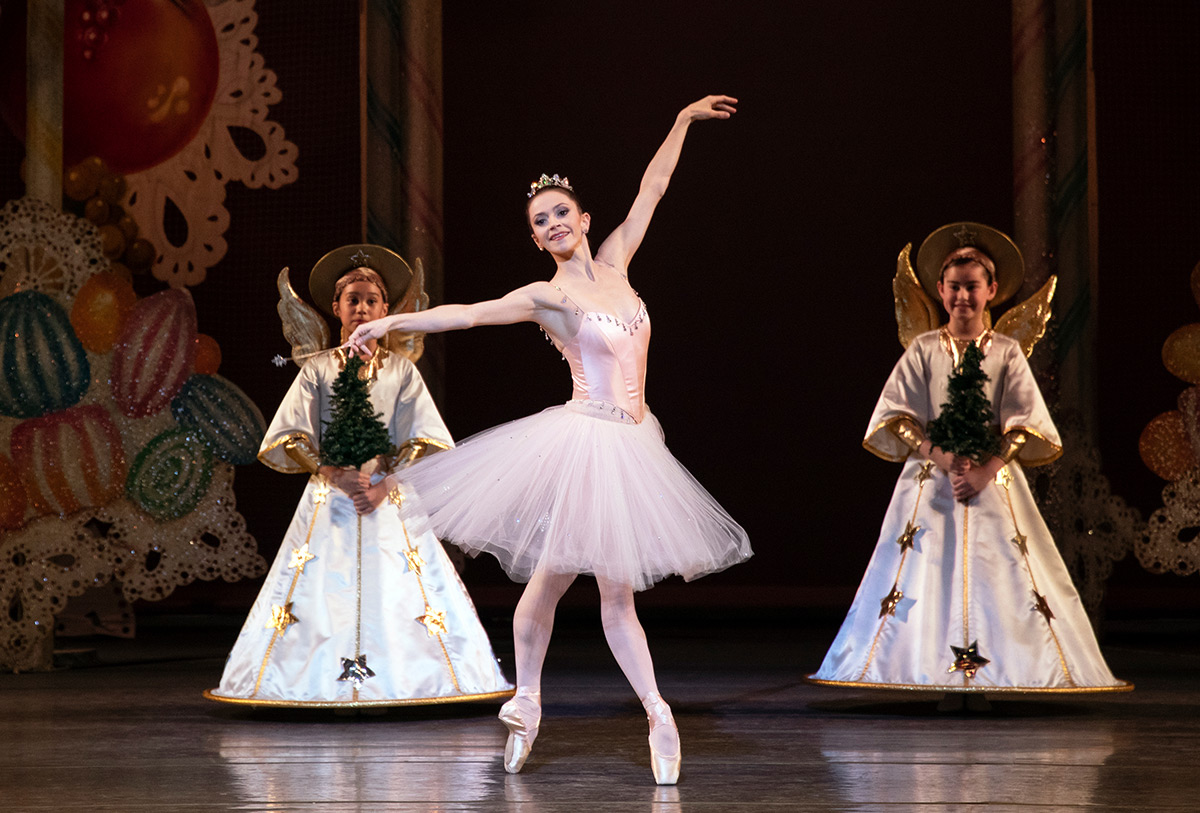
© Erin Baiano. (Click image for larger version)
New York City Ballet
The Nutcracker
★★★★✰
New York, David H. Koch Theater
27 November 2021
www.nycballet.com
davidhkochtheater.com
A Tree Grows in Manhattan
One of the most depressing aspects of last year was the impossibility of certain rituals: gathering for the holidays, traveling to see friends. And, for those who live in cities and towns that have a ballet company: bundling up to go watch a performance of Tchaikovsky’s great children’s ballet The Nutcracker – a symphony of childhood, as the Russian musicologist Boris Asafiev referred to it.
It is a measure of where we are now that live Nutcrackers, which are also an important source of revenue for cash-strapped dance companies, have mostly returned. With precautions. In the case of New York City Ballet’s production, choreographed by George Balanchine in 1954, there are fewer kids onstage this year, and those kids are older, twelve and above when rehearsals began in the fall. (Twelve was the cut-off age for vaccination at the time). Accommodations had to be made, as well as new costumes.
On opening night, Nov. 26 (the day after Thanksgiving), there were noticeably fewer children in the audience than in other years. Kids under 12 who weren’t vaccinated needed to have proof of a negative PCR test. But the theater was full, and the anticipation great. The dancers, who will perform the show dozens of times over the course of December, were still fresh. The kids, taller than usual and wearing newly-sewn dresses, hit their cues perfectly, as they usually do. This year they were drawn not only from the School of American Ballet, but from ballet schools across New York, a fact reflected in the wider palette of skin tones on the stage – a happy sight.
Athena Shevorykin, as Marie, was touching without being cloying. She walked with great serenity into the forest after her heroic encounter with the Mouse King, in which she removes a slipper and strikes him in the back, distracting him long enough to allow the Nutcracker to fell him with his sword. Reed Ouimet, in turn, was a noble and sincere Nutcracker Prince. (I am particularly fond of the “magic handshake” that happens between the two, three times during the first act.) Perhaps the fact that they’re a little bit older than the usual performers imbues them with more personality, more pathos.

© Erin Baiano. (Click image for larger version)
As always, the ballet offered stirring moments of transformation, like the one in which the Nutcracker Prince’s costume is snatched away to reveal a small (or in this case not-so-small) boy in a pale pink suit. It is one of the ballet’s great coups de théâtre, a moment in which, for reasons you don’t quite understand, your heart catches in your throat. (It’s the music.) Another is the moment the Christmas Tree grows to monstrous proportions. And yet another: Sugarplum’s glide across the stage on a tiny platform that is invisible to the audience. Moments of magic, accompanied by some of Tchaikovsky’s most soul-stirring music. The orchestra’s rendition, under the baton of Andrew Litton, was brisk and compact. The one false note was the tinny rendition of a recorded children’s chorus during the Waltz of the Snowflakes.
Much of the mime in City Ballet’s Nutcracker is pro-forma – the company is not known for its acting – but it gets the job done. Balanchine created such a solid structure that the ballet just rolls along: characters arrive and depart, misbehave, converse, and perform social dances together. The fathers dance with their daughters; the kids dance on their own; and then the adults and children dance side by side. The exception to this sense of order is Robert La Fosse’s Drosselmeier, who infuses the proceedings with a touch of eccentricity and danger. La Fosse reacts to each child, dances a solitary jig, and, at a point late in the party, projects a touch of weariness (secretly taking a swig from his pocket flask). You understand perfectly why Marie is drawn to him, and why his gift means so much to her.
Then there are the many cameos that make The Nutcracker a proving-ground for young dancers. KJ Takahashi, a recent hire, was impeccable as the toy soldier in the party scene, with his clean turning jumps, each of which ends facing a different direction, and beautiful entrechat sixes with flexed feet. The second act “tea” dance, purged of its clichéd pseudo-Chinese finger-pointing, now feels aimless and begs for new choreography. But Roman Mejia, with his giant arrow-like jumps and double tours, and, even more, his smiling charm, almost makes you forget the inanity of the steps. Coffee, a pseudo-Arabian exotic dance, was performed by Georgina Pazcoguin, with more seriousness and emphasis than this rather tongue-in-cheek dance deserves.

© Erin Baiano. (Click image for larger version)
The ballet’s most difficult and sophisticated dancing is executed by The Sugarplum Fairy and her Cavalier, and by Dewdrop, star of the Flower Waltz. They were danced here by Megan Fairchild, Gonzalo García, and Tiler Peck respectively. Balanchine placed Sugarplum’s solo at the beginning of the second act, as a way of setting the tone for the Land of the Sweets. Fairchild looked warm and relaxed as she interacted with the angels at the start of the solo and then launched into the delicate, exposed choreography. Despite a touch of instability at the start – she lost her magic wand somewhere along the way – Fairchild showed no sign of strain and glided onward, like the pro that she is. Her slow, controlled attitude turns were particularly lovely. And the final, climactic pas de deux with García was polished off with ease, as she popped onto his shoulder like a kernel of popcorn, and he tossed her into a final fish dive with the assuredness of someone who has performed the move a thousand times.
Meanwhile, Tiler Peck simply took the audience’s breath away with her control and finesse in the windswept role of Dewdrop. Jumps, turns, balances, the solo has it all, but what you noticed here was Peck’s extraordinary musicality, the way she linked the steps into phrases, holding a pose until the last moment, comfortable even while tipping off-balance, in the knowledge that she would catch herself just in time to launch into a flurry of staccato pointework. Even when she stood still, her body was like a tense bow, ready to shoot.

© Erin Baiano. (Click image for larger version)
The final applause was as warm as I have ever heard it, tinged with gratitude, for the return of a spectacle at once so grand and so intimate: the enormous tree, the buckets of snow, the mysterious forest, the luminous dancers, the kids. It’s no wonder people keep coming back.












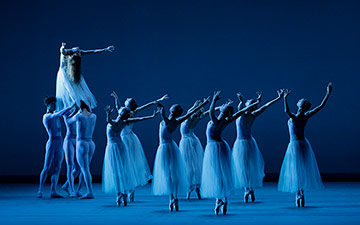
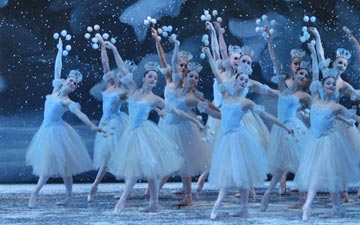
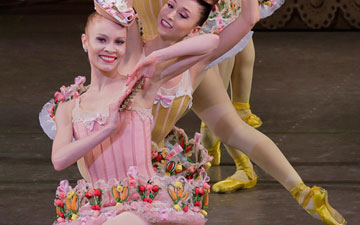
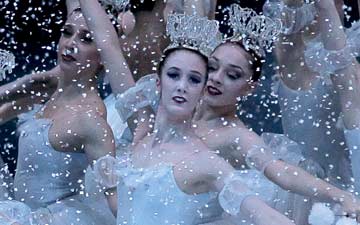

You must be logged in to post a comment.